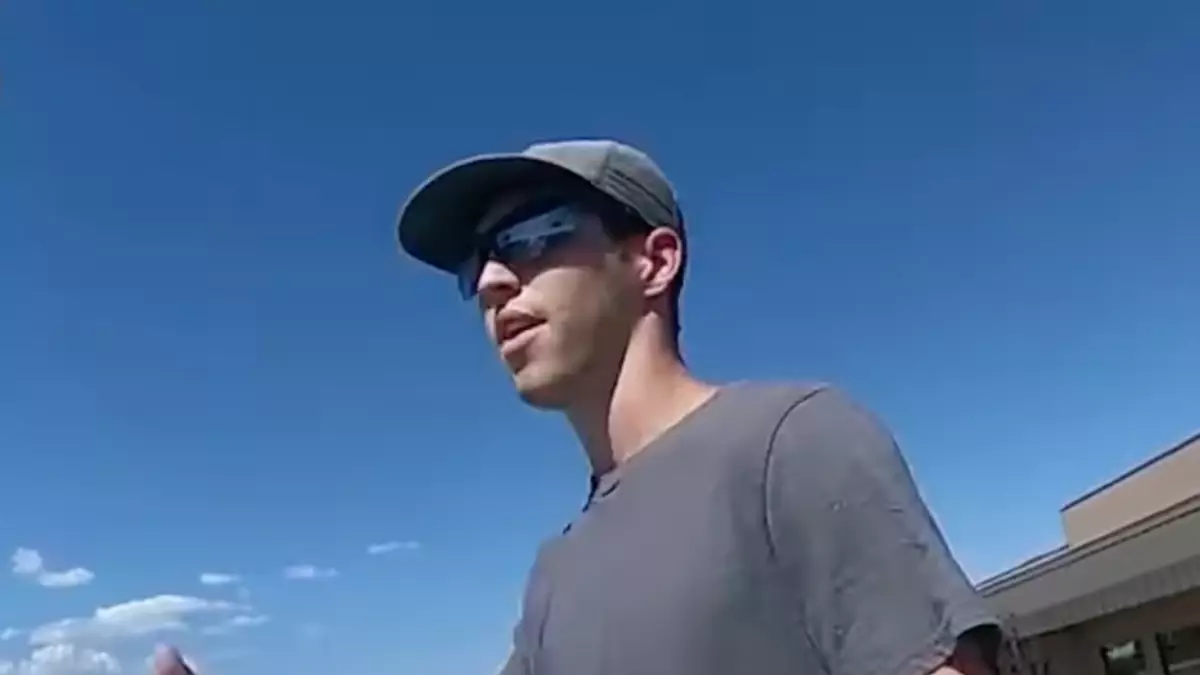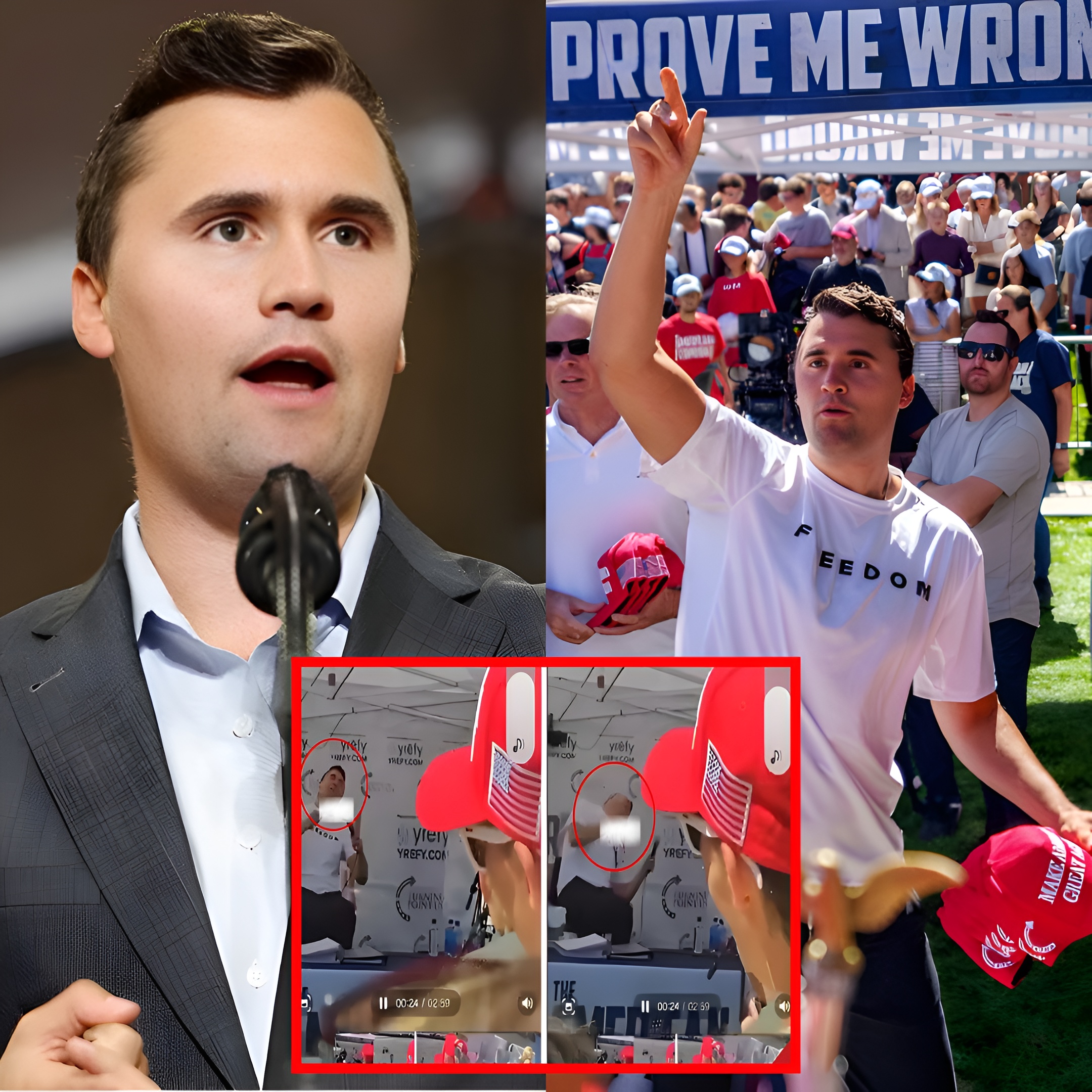The final moments of Charlie Kirk sent social media into a frenzy — 30 seconds that left everyone speechless, 3 minutes of silence no one could explain — but what happened afterward changed everything, leaving even his closest allies lost for words.
It began as an ordinary evening at Utah University — a scheduled forum, a hall filled with energy, and Charlie Kirk standing on stage, his presence commanding yet familiar. The audience expected a sharp discussion, perhaps a debate about culture, campus life, or free expression. What no one expected was that this particular night would end up being remembered across the nation for reasons no one could have imagined.
For months now, the conversation surrounding those final minutes has refused to fade. The video — now referred to simply as “the three-minute clip” — has become a cultural flashpoint. It is a moment frozen in time: a man, a microphone, a sudden silence, and a mystery that continues to haunt everyone who was there.

The Night That Changed Everything
Witnesses say the evening began like any other event featuring Kirk — spirited, fast-paced, full of sharp exchanges between students and speaker. Phones were out, the livestream was active, and the first twenty minutes moved without a hitch.
But then came a pause. A subtle shift. The moment the energy changed, several audience members later said they felt “something unexplainable” — a strange tension in the room. One student who sat in the third row described it as
“a silence that didn’t make sense — like everyone was waiting for something, even though we didn’t know what.”
The video that later surfaced captured those seconds in eerie clarity. Charlie was mid-sentence. Then he stopped. He looked toward the left side of the room — not in confusion, not in panic, but as though he heard something no one else could. He smiled faintly, placed his notes down, and stood completely still.
That was the moment when the hall fell silent.

The Viral Clip
The first clip that leaked was only 30 seconds long. It spread faster than anyone expected — shared across platforms, reposted by accounts from every side of the political spectrum. It wasn’t what was seen that shocked viewers; it was what
wasn’t. The sudden silence, the faint hum in the audio feed, and the expression on his face left thousands of viewers trying to interpret what it all meant.
Some said it looked like he had realized something profound. Others said it was simply a technical pause — a glitch, a microphone issue, a break in transmission. But the intensity of that moment couldn’t be ignored. In the 30-second span, everything felt suspended — a man, a crowd, and a mystery.
What came after that, however, deepened the story.
The full version of the video, clocking in at a little over three minutes, was quietly uploaded days later by a student who claimed to have been sitting near the stage. That version revealed details that the public had never seen before — moments of confusion, people standing up, someone in the background saying,
“Is he okay?”, and the camera shaking as the audience tried to process what they were witnessing.

Reactions from the Crowd
The clip went viral not just because of what it showed, but because of what it made people feel.
In the comment sections, debates erupted — some arguing that the footage had been taken out of context, others insisting that something extraordinary had happened that night. But nearly everyone agreed on one thing: the silence was unforgettable.
A student journalist from the campus paper described the atmosphere in chilling terms:
“It wasn’t chaos. It wasn’t fear. It was quiet — the kind of quiet that feels like time stopped.”
Those who were there said they could still recall the sound of a phone dropping somewhere in the audience, the soft hum of the air conditioning, and the sight of a thousand faces frozen in confusion.

The Official Response
When university officials were contacted for comment, they released a short statement thanking the community for their “respect and patience” as they reviewed the circumstances surrounding the event. They neither confirmed nor denied anything unusual about the night, and for many, that silence only fueled the speculation.
One senior administrator, speaking off the record, said that internal discussions about how to handle the situation were “tense, emotional, and cautious.”
“It’s not just about what happened,” the administrator said, “it’s about what people
think happened. And perception spreads faster than any truth we could ever publish.”
The administration later clarified that the footage had been reviewed for accuracy and authenticity, but that “out of respect for privacy and context,” certain segments would not be made public. That statement — especially the phrase
“out of respect” — left many wondering what, exactly, had been omitted.
The 3 Minutes That No Outlet Dared to Air
Major media outlets reached out for copies of the full recording but were reportedly advised against publishing it in full. “Too sensitive,” one producer told a journalist who later described the exchange online. The hesitation only amplified curiosity.
Then, in the following days, fragments of the clip began to circulate online — blurry screenshots, isolated audio segments, and conflicting accounts of what those final seconds contained.
Some viewers claimed to hear faint words near the end — a short phrase, barely audible through the microphone. Others dismissed it as distortion.
But it was that idea — that maybe there were words no one was supposed to hear — that pushed the story beyond speculation and into something much bigger.
A Nation Divided Between Belief and Skepticism
Across social media, millions debated whether the footage revealed something profound or whether the entire narrative had been twisted by online rumor. Hashtags trended overnight. Talk shows brought in analysts, audio experts, and even behavioral psychologists to study Charlie’s expression in those moments.
One commentator said,
“It’s not what we saw — it’s what we felt watching it. That’s why people can’t move on. It’s a feeling that stays with you.”
The emotional gravity of the footage turned what might have been a passing news story into a nationwide conversation about presence, silence, and legacy. Why did the video feel so personal? Why did so many people describe it as “unexplainably emotional”?
Perhaps because, for years, Charlie Kirk had been more than a name. To supporters, he was a voice — sometimes controversial, always sharp, never indifferent. Seeing that voice pause, seeing him frozen mid-thought, struck a nerve that words couldn’t quite describe.
Inside the University
Several faculty members later shared their own perspectives. One lecturer described the aftermath as “deeply human — people crying, others sitting quietly, unsure whether to leave or stay.” Another student mentioned that classes the next day felt different.
“Everyone was talking about it, but no one knew what to say,” she recalled. “You could tell people were moved, but no one understood why.”
Behind closed doors, the university’s communications team reportedly worked around the clock to manage inquiries from journalists, parents, and donors. An internal memo, later obtained by a regional outlet, suggested that the school’s leadership wanted to “maintain respect, compassion, and factual clarity” in every response.
Still, the public’s fascination grew.
The Emotional Fallout
Within days, tributes flooded social platforms — messages, artwork, and clips set to soft piano music, shared by followers and students alike. The hashtag
#CharlieMoment trended across platforms, symbolizing both respect and disbelief.
People began revisiting old videos, interviews, and speeches, looking for meaning, signs, or closure.
Even those who had once disagreed with his views found themselves pausing to reflect.
“It’s strange,” one user posted, “but this clip made me realize how unpredictable life is. No matter what side you’re on, that silence said everything.”
The Words That Sparked Debate
Toward the end of the three-minute clip, just before the feed cuts off, there’s a faint sound — like someone speaking softly, almost whispering. Many believe it was Charlie. Some say it was someone near the microphone. Others say it was just static interference.
But the debate surrounding those supposed “final words” became one of the most intense parts of the entire story.
Some claimed they heard the phrase “It’s okay now.” Others swore it was “Tell them I understand.”
The truth, as of now, remains uncertain.
What matters more, perhaps, is not the phrase itself, but what people found within it — comfort, sadness, peace, or closure. It was as though every listener heard what they needed to hear most.
The Legacy Beyond the Silence
Weeks after the footage first appeared, university staff organized a private reflection event. It wasn’t a vigil, nor was it a rally — it was something quieter. Students gathered in the same auditorium where it all began, the lights dimmed, the air still. The event lasted just thirty minutes. There were no speeches, no cameras, just presence.
A statement displayed on the screen read:
“Sometimes, the moments we don’t understand are the ones that define us most.”
The words felt heavy, yet strangely healing.
From that day forward, people stopped asking what happened and began asking why it mattered so much. And maybe that’s the real story — not the silence itself, but the reflection it created in those who witnessed it.
The 30 Seconds That Still Echo
Months later, people still revisit the clip. They analyze it frame by frame, yet no one can quite explain the emotional pull. It’s become a symbol — a reminder of fragility, connection, and the weight of moments that defy explanation.
Somewhere between fact and feeling, the video continues to live on — not as evidence, not as mystery, but as memory.
And maybe that’s enough.
Because in those 30 seconds, when the entire room went silent and no one knew why, something universal was revealed — something about presence, time, and the way a single moment can change everything.
